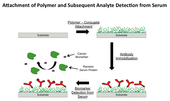Highlight
Novel Polymer Coating for Nanoscale Cancer Diagnostics
Achievement/Results
NSF-funded researchers at the University of Washington (Prof. Shaoyi Jiang) and the Massachusetts Institute of Technology (Prof. Scott Manalis) collaborated to develop an improved method for cancer diagnostics using nanoscale biosensors. The NSF-funded Integrative Graduate Education and Research Traineeship program (IGERT) in nanoscale science and engineering at UW focuses on bridging the gap between nanotechnology and medicine. Currently, a disconnect between sensor capabilities enabled via nanotechnology and the surface chemistry necessary for practical applications has limited significant advancements in cancer diagnostics. Improved treatment of cancer patients will rely on the ability to sensitively detect biomarkers directly from the complex environment of blood serum.
Recent funding from the NCI enabled Professor Manalis to develop a nanoscale biosensor platform capable of sub-femtogram resolution (10-15 grams) as highlighted in Nature. This was remarkable because it enabled the mass measurement of single cells, proteins, and nanoparticles, “in” solution. Due to its tiny flow-channels, commercially available surface coatings were insufficient to meet the demanding needs for detection in complex media, such as blood serum. Hence, a unique material which allowed for its convenient attachment, used simple detection protocols, and prevented adsorption of undesired proteins from the serum was necessary.
The new technology implemented here by IGERT Trainee Norman Brault was based on a material developed by Prof. Jiang. First, a novel dual-functional polymer was linked to an adhesive molecule capable of strongly adhering to numerous materials. This unique polymer not only prevents non-specific protein adsorption (i.e. undesired proteins from serum) to the sensor surface but also allows for specific detection of target analytes by attaching recognition molecules (e.g. antibodies). Next, implementation of the polymer conjugate ensued by discovering the conditions necessary for its convenient attachment from an aqueous solution onto the surface of the biosensor. This was followed by developing conditions for antibody immobilization onto the polymer and the subsequent detection of cancer markers, as shown below. The successful use of this polymer conjugate significantly outperformed the commonly used ?gold standard? surface coating and enabled the highly sensitive and direct detection of cancer biomarkers from undiluted serum.
Address Goals
The design and implementation of this novel polymer conjugate onto the surface of a nanoscale biosensor allows for significant advancements in the field of cancer diagnostics. The ability for it to attach to a variety of surfaces and subsequently allow for sensitive and specific detection of desired molecules makes it highly attractive. Following this work, the material was also provided for implementation on additional sensors at the California Institute of Technology, Oak Ridge National Laboratory, and Northwestern University. This illustrates its potential as a critical investment for advancing instrumentation for numerous medical applications.






